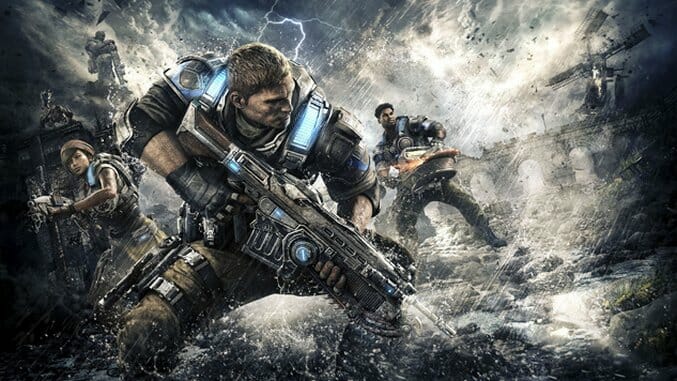Gears Of War 4 is Comforting Despite the Clutter

The first Gears of War trilogy was a pillar of any LAN party in the Xbox 360 era. Despite existing in a market oversaturated with multiplayer shooters, even directly competing with another Microsoft exclusive, it found a niche and played into it. The “bro-tastic” perception of Gears is not undeserved, though it paints the series in a less negative light than it sounds. Gears offered cooperative play in the best ways, through campaign and horde, and its hulking band of buddies that would make a Predator casting call blush grew into memorable faces.
Gears of War 4 brings the series into a new generation with the same determined focus of its predecessors. There’s no denying Gears of War 4 is a house built with blueprints; you will roadie run into cover, pop up and down like prairie dogs and chainsaw enemies in half with the infamous Lancer.
What makes Gears of War 4 work is the way it satisfies those creature comforts, a need for exactly this kind of experience, polished and shiny on a new system. The Coalition had a lot to tackle when it inherited the series from Epic Games, but smart choices on when and where to innovate, and when to not fix what isn’t broken, make Gears 4 a welcome surprise.
Set a full generation after the end of 3, the player is dragged through a short prologue that summarizes the conflict of the first trilogy before being introduced to the new generation of Gears. JD Fenix takes the lead role, alongside frat COG buddy Del and outsider Kait. The parallels to the original Gears of War are clear at first, but the cast quickly establishes itself as a unique unit. JD is headstrong but brash, Del’s comic relief runs parallel to his loyalty to the crew, and Kait is aggressive and endearing, a welcome change from the series’ previous female leads. Over time, you get to delve into the nuances, and through clever pacing and a surprising amount of quiet moments between firefights, you get glimpses of actual character development. I enjoyed the original Gears cast for their charisma, the bombastic “woo’s” of Cole and their banter during combat. JD, Del and Kait still have good banter, but they take the time to chat and actually care about each other during their journey.
Gears of War 4’s campaign is definitely a road trip, starting with a raid-gone-wrong and pinwheeling into a global crisis. It’s over-the-top, but comes with a self-awareness that keeps the grandeur in check. This is best characterized in the return of Marcus Fenix, a section that is almost sublimely tongue-in-cheek; “old man” Marcus is settled-down, no-nonsense, but has empathy for the new generation and fills a father-role for all of them, not just JD. At the same time, he can drop a one-liner with ease, with enough cheese that you expect him to turn to the camera and wink.
The chemistry of the cast pushes the story forward more than anything else. As a whole, this isn’t quite the best in Gears campaigns. It starts strong, with a new cast, a bright world free of Locust, and a new enemy in the COG’s automated robot enforcers. Pitting the newcomers against the classic good guys isn’t just an interesting twist, it provides combat situation that feel unique compared to the common conceit of Gears.
Flying Guardians and rolling, self-destructing Trackers force you out of your comfort zone, away from that one perfect piece of cover you’ve been ducking behind and around the arena. New mobility options, like yanking enemies out of cover for executions, and weapons like the Dropshot, which flies overhead and then drops an explosive on foes, give both you and your enemies more options for coping with cover, a welcome change of pace that keeps the action from becoming stagnant.
The world of the first two acts of Gears of War 4 is vibrant, violent and invigorating. When it comes to the latter half of the campaign however, the pacing slows to a grinding halt. Old enemies get rehashed, and the game starts to feel too familiar. Combine this with the maddening, increasing pace of conflicts that are little more than ever-expanding meat lockers of enemies to mow down, and Gears 4 ends up struggling until its final act, where it does away with pretense and brings out the biggest set pieces and guns.
The clever bits of the campaign are where the designers introduce diluted elements of Horde, the mode that for many (myself included) will be the determining factor of whether to boot up Gears again after the credits roll. I’m not as competitive in Gears as other shooters; I find myself constantly drifting to the never-ending onslaught of Horde over the multiplayer modes, and with Gears of War 4, Horde is once again the main attraction post-campaign.
Horde 3.0, as The Coalition calls it, is fleshed out to an irrational amount. The Fabricator, a mobile base that players can move around the map, allows you to craft a bevy of static defenses in exchange for power, a currency earned for killing enemies and clearing waves. Before the match begins, each of the five players in a Horde match selects a class and equips bonuses to accentuate their class’ strengths. Scouts get extra power when they pick it up during a firefight, engineers get better build options and discounts, and the rest of the classes (Soldier, Heavy and Sniper) focus on downing enemies.
-

-

-

-

-

-

-

-

-

-

-

-

-

-

-

-

-

-

-

-

-

-

-

-

-

-

-

-

-

-

-

-

-

-

-

-

-

-

-

-









































